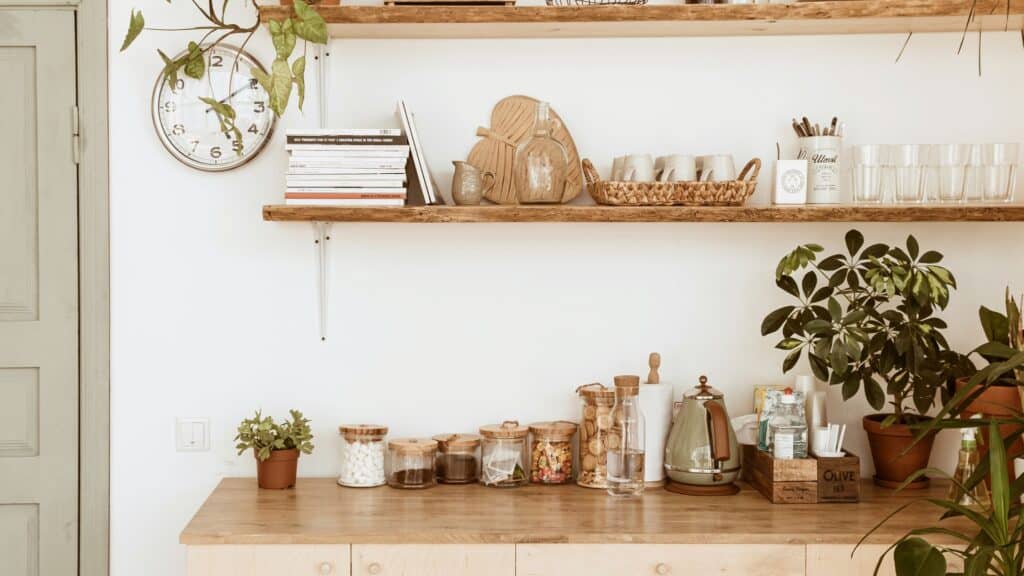Adopting new habits is often necessary to keep clutter under control, either by keeping it tidy or by getting rid of it when there is too much of it. If you are wondering how to organize a house full of clutter, we will outline the top strategies and habits you can use today to clean a messy house!
How To Organize The Whole House
If you share a home with others, you’ll also need to ask your family members or roommates to follow the same habits. If you don’t collaborate on this with your family, your attempts to organize and declutter will probably be overshadowed by the trash that others have accumulated.
Consider it this way: You can only keep clutter at bay if you live an orderly lifestyle since tidying up is more than just an activity.
Clean house tips:
- Set a regular time to tidy up, preferably once a week or every other week
- Get rid of anything that hasn’t been used in the last year
- Throw away, recycle, or donate what you don’t need (but above all donate and recycle)
How To Organize A Household – 9 Top Strategies And Habits
Here are our nine top strategies and habits you can implement to organize your house:
- Change the perspective and ‘don’t get used to it’
- Ask yourself the right questions
- Create a routine of periodic ‘actions’
- Strategies and actions to organize your home
- Divide and list
- Take care of the mail
- One garbage bag per day
- Roll and donate one item a day
- The four boxes
- One month in the carton

1. Change Your Perspective
Because most individuals lose interest in clutter quickly, this is one of the reasons it can be so challenging to remove. Many people develop immunity to the issue when a room or a house is disorganized for an extended period of time. Some people even lose the memory of how their home looked like before it became cluttered. In other words, chaos spreads across the ecosystem.
Most individuals require an outsider’s viewpoint to understand the scope of the issue. So ask your parents, niece, trusted friend, or neighbor to examine each area in your home and offer their opinions.
Ask questions as you inspect each shelf, cabinet, or storage space and sort through the clutter (you might also be interested in checking out the best outdoor shelving options).
For instance:
- How would you organize this?
- What would you throw?
- What do you think is the best organizational system for this space?
These questions will help you come up with ideas to advance your tidying efforts.
2. Ask Yourself The Right Questions
Even if you’re cleaning out your home alone, it’s crucial to think through your options as you sort through your clutter in order to create a strategy for the future.
Do I Really Need This Item?
For various reasons, most individuals keep stuff they don’t need. People sometimes maintain objects they associate with memories because discarding them would be the same as erasing the memory. But it’s vital to understand that those things aren’t memories; instead, memories endure long after the things have gone.
A lot of people also save things out of fear that they might need them again in the future. It’s useful to remember when decluttering that if an item hasn’t been used in a year, it probably won’t be required in the future.
Can I Trade This For Inner Peace?
This is a very important question since chaos destroys tranquility and holding on to clutter is the same as replacing peace with it. Many people find it beneficial to consider the connection between clutter and inner serenity by posing this question while they are organizing their homes.
3. Create A Routine – Minimalist Tips For Decluttering
Routines for organizing shouldn’t be taxing. Create the practice of tidying up every day and periodically throughout the year, and spend extra time performing more thorough cleanup.
Daily Order
Recognize the sections of the house that accumulate clutter more quickly (for instance, the kids’ play area), and tidy such areas every day. Check your mail on a daily basis. Recycle what you don’t need and save what you do.
Quarterly Order
Every three months, set aside some time to deep clean a different part of the house. The following areas normally need to be addressed every three months or so:
- Garage
- Attic
- Basement
- Wardrobes
- Storage areas
- Guest room
Create a strategy at the start of the year to guarantee that the hardest-to-clean portions of your home will be organized precisely as required. Do it on a monthly basis if quarterly tidying is insufficient to get the entire house clean and organized.
4. Implement Strategies To Organize The House
You are probably nodding as you read since that is the theory. However, implementing it is not always that simple. We hope some of these strategies will be useful to you in successfully implementing these habits.

4.1 Declutter Your Home Checklist
Make a to-do list after evaluating the mess in your home. Make a list of the jobs to be completed in each zone of your home after dividing it into sections.
Next, pick when you will finish each zone and how long it will take you to complete it. To ensure that your home is completely organized by the end of the year, extend the to-do list to cover the entire calendar.
4.2 Deal With Your Mail Immediately
Take regular care of your mail because it might accumulate easily. As soon as you receive something, throw it away or recycle it. When it comes to what you actually need, pick a location where it won’t be misplaced or forgotten and purchase a mail organizer to store the papers within.
You should get an organizer with distinct slots for bills, coupons, advertising, and other forms of mail, along with labels for each category. At the end of the week, place the order for the organizer and show your family or roommates how to utilize it. The only way to keep it from becoming disorganized and losing its usefulness is to do so.
4.3 Fill One Garbage Bag A Day
Anyone who needs to quickly get rid of clutter will benefit from this deep cleaning method. Opening boxes, checking shelves, doing laundry, and organizing closets are the first things that you need to do every day. Cleanup day is over when a garbage bag is full.
Who Should Use This Method To Clean A House?
This quick cleaning schedule is a terrific method to get a house in order as the deadline draws near. This strategy is quick and efficient without being overly burdensome. This is especially the case when you are expecting visitors or when you want to list your home for sale.
If you have a room with too much stuff, use this strategy. For instance, the method can be used if a space in your home has been transformed into a storage room over time, such as a garage, loft, or basement. Often, people who employ this technique have lived in their homes for a long time and have allowed clutter to build up.
4.4 Drop Or Donate An Item Every Day – Clean A Messy House
Choose a piece of furniture to donate or dispose of each day as you clean. Although this strategy doesn’t get rid of clutter very quickly, it’s a smart way to stop clutter from building up in the long run.
Who Should Use This Method?
The people who use this method are those who typically already keep a well-organized home. They do not have a significant problem with the accumulation of things and do not need to get rid of them quickly. They can avoid clutter problems by taking this action.
4.5 Use The “Four-Box” Method To Clean House Efficiently
Any area can be decluttered using the “four boxes” method, including a bookcase, closet, or bedroom. Get four medium (or large, depending on the size of the area you are organizing) boxes or storage containers to get started, then mark each box as follows:
- Keep – anything you want to keep
- Doubtful – any items you’re not sure you want to keep or what you want to do with
- Throw – anything you decide to throw away
- Donate – anything you can donate. Or a miscellaneous box, with things to break, recycle, etc.
Place the matching items in each of the four boxes after labeling them. When the boxes are filled, take the time to empty the “Throw” box, return the goods in the “Keep” box, etc. It is simpler to decide what to do with the items in the “Doubtful” box once you have decided what to keep and what to discard.
4.6 Take The “One Month In A Cardboard Box” Test
This test can help determine which commonplace items are required and which are not. Typically, it is used to organize little places like cabinets and drawers. Put whatever you need to sort in the area in a cardboard box. Leave everything in that box back where it belongs after usage.
What you haven’t used in a month is not necessary, so donate it or give it to your friends. You can repeat this experiment with items like clothing, trinkets, DVDs, etc. in different rooms of the house.
If you conduct the test throughout the year in various parts of the house, at the end of the year you will have succeeded in getting rid of a sizable amount of junk.
